Statusrapport
Food Security In A Climate Perspective Annual Report 2013
About one billion people are chronically undernourished, according to recent UN estimates. With the global population growing to an estimated nine billion people by 2050, food production needs to increase by approximately 70 percent. At the same time, climate change may seriously impede important parts of global food production. Economic growth also translates into a higher demand for animal proteins. With more mouths to feed, demanding more resource-intensive diets, the ecological footprint of agriculture also needs to be reduced in order to meet climate policy goals. This will require large and sustained efforts by the global community. How the world can feed a growing population in a manner that advances economic development, reduces pressure on the environment and adapts to climate change is a challenge described as a “great balancing act” by a recent World Resources Report. This balancing act will be more acutely felt in some areas, particularly rural Africa, where rates of food insecurity and poverty are already high. To address poverty, agriculture needs to grow in ways that provide economic opportunities to the poor. Roughly two billion people are employed in agriculture, and many of them are poor and food insecure. The majority of agricultural workers, fish processors and vendors in many developing countries are women. Raising women’s income has disproportionate benefits for alleviating hunger and improving the livelihoods of children and families. Assisting women in their food production and marketing is therefore a particularly effective way to reduce poverty and enhance food security.
